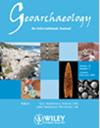非海洋介形类在地质考古中的代用研究进展
IF 1.4
3区 地球科学
0 ARCHAEOLOGY
引用次数: 2
摘要
介形类作为生物指示物,在古环境和古气候重建中具有重要意义,也可用于指示沉积物和物质的来源,例如在古代商业网络研究中。介形虫是一种小型甲壳类动物,几乎生活在所有的水生栖息地,无论是自然的还是人为的。由于它们的钙质外壳,它们具有很高的石化潜力,在过去的几十年里,它们在地质考古中的应用一直在稳步增加。它们的小尺寸需求意味着只需要少量的沉积物样本,并且物种特定的生态耐受性和偏好允许详细的古环境重建。它们的典型应用方法是基于生态信息和地形学、形态变异和壳稳定同位素和化学分析的组合古生态学分析。本文综述了非海洋介形类在(地质)考古研究中的应用,推荐了采样和分析技术,以解决古气候、生境和景观变化、水的可用性和质量、土地利用和其他人为影响、材料来源和商业网络等考古研究问题,以促进介形类在地质考古/环境考古中的应用。本文章由计算机程序翻译,如有差异,请以英文原文为准。

Nonmarine Ostracoda as proxies in (geo-)archaeology — A review
Ostracods as bioindicators are extremely useful for reconstructing palaeoenvironment and palaeoclimate and can also indicate the provenance of sediments and materials, for example, in studies on ancient commercial networks. Ostracods are small crustaceans that live in almost all aquatic habitats, both natural and man‐made. Due to their calcitic carapace, they have high fossilization potential, and their use in geoarchaeology has been steadily increasing during the last decades. Their small size needs mean that only small volumes of sediment samples are needed, and species‐specific ecological tolerances and preferences allow detailed palaeoenvironmental reconstructions. Typical methods of their application are palaeoecological analyses of associations based on ecological information and taphonomy, morphometric variability and stable isotope and chemistry analyses of their shells. The present paper aims to present an overview of applications of non‐marine ostracods in (geo‐)archaeological research, recommending sampling and analytical techniques for addressing archaeological research questions on palaeoclimate, habitat and landscape changes, water availability and quality, land use and other anthropogenic impacts, the provenance of materials and commercial networks to promote the application of Ostracoda in geoarchaeology/environmental archaeology.
求助全文
通过发布文献求助,成功后即可免费获取论文全文。
去求助
来源期刊

Geoarchaeology-An International Journal
地学-地球科学综合
CiteScore
3.60
自引率
5.90%
发文量
51
审稿时长
>12 weeks
期刊介绍:
Geoarchaeology is an interdisciplinary journal published six times per year (in January, March, May, July, September and November). It presents the results of original research at the methodological and theoretical interface between archaeology and the geosciences and includes within its scope: interdisciplinary work focusing on understanding archaeological sites, their environmental context, and particularly site formation processes and how the analysis of sedimentary records can enhance our understanding of human activity in Quaternary environments. Manuscripts should examine the interrelationship between archaeology and the various disciplines within Quaternary science and the Earth Sciences more generally, including, for example: geology, geography, geomorphology, pedology, climatology, oceanography, geochemistry, geochronology, and geophysics. We also welcome papers that deal with the biological record of past human activity through the analysis of faunal and botanical remains and palaeoecological reconstructions that shed light on past human-environment interactions. The journal also welcomes manuscripts concerning the examination and geological context of human fossil remains as well as papers that employ analytical techniques to advance understanding of the composition and origin or material culture such as, for example, ceramics, metals, lithics, building stones, plasters, and cements. Such composition and provenance studies should be strongly grounded in their geological context through, for example, the systematic analysis of potential source materials.
 求助内容:
求助内容: 应助结果提醒方式:
应助结果提醒方式:


